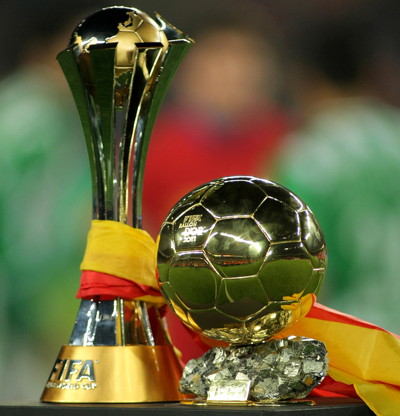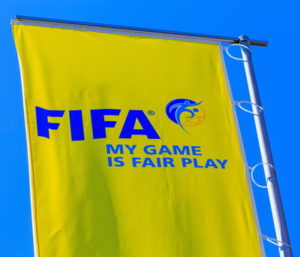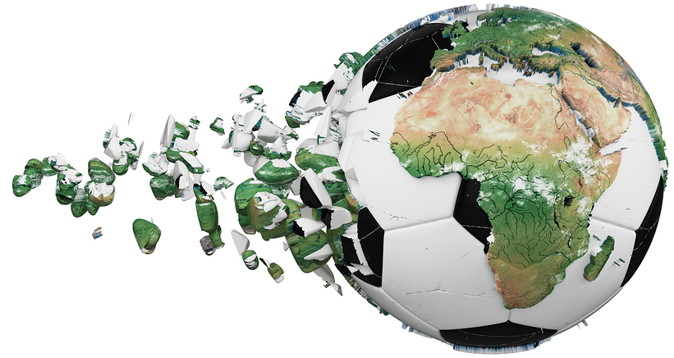FIFA Club World Cup Betting Offers: United States 2025
 The club world cup is frankly a money spinning event dreamt up by FIFA, hence why it is held in nations like Saudi Arabia, Qatar, China and the UAE. Still you can’t ignore the fact that is one of the only opportunities for the leading clubs from different confederations to play against each other.
The club world cup is frankly a money spinning event dreamt up by FIFA, hence why it is held in nations like Saudi Arabia, Qatar, China and the UAE. Still you can’t ignore the fact that is one of the only opportunities for the leading clubs from different confederations to play against each other.
In the past it was seen as more of a headache than anything else for many of the UEFA clubs involved in the tournament, having to take time out of a busy winter schedule at home to fly halfway around the world to play. The fans didn’t necessarily see it that way though and the cup has become a bucket list prize for their clubs to win.
This will be the 21st edition of the club world cup and will be the first of the new format competition with the United States hosting. The new format will feature 32 teams across 8 venues in 8 host cities with clubs from all 6 confederations, along with one from the host nation. Teams are split into 8 groups of 4 with the winners and runners-up progressing to the knockout rounds.
The profile of the event is due to rise, however, with the expansion to 32 teams. It will move to the summer and will be held every four years – although this has been delayed until 2025 due to potential clashes with the other national tournaments. Of course, the main driver of this is to increase revenues, but fans are cautiously welcoming a more competitive club world cup.
On this page find all the leading betting promotions and features for the tournament along with event and schedule details.
FIFA Club World Cup Betting Offers for 2025
This event has not started yet, please check back nearer the time. For other offers see our main loyalty page.
About The Club World Cup
 When a British team wins the Champions League the inclination from the supporters of the team and the press is to declare them to be the best team in the world. That is based on the idea of all of the top leagues being based in Europe, therefore ensuring that the winner of Europe’s most prestigious club competition can rightly feel as though they’re one of if not the best clubs in the world.
When a British team wins the Champions League the inclination from the supporters of the team and the press is to declare them to be the best team in the world. That is based on the idea of all of the top leagues being based in Europe, therefore ensuring that the winner of Europe’s most prestigious club competition can rightly feel as though they’re one of if not the best clubs in the world.
Yet that is at least slightly dismissive and disrespectful of the other federations aside from UEFA that come under FIFA’s jurisdiction. Federations covering Africa, Caribbean and South American football would all argue that they have as much right to be in the conversation as producing the ‘best’ football in the world as Europe does, for example.
That was essentially the thinking behind the formation of the FIFA Club World Cup, putting together the winners of the various federation tournaments throughout the season. The competition is the deciding factor of the club that gets to call itself the world champions each year.
It has only been taking place since 2000 and originally ran in parallel with the Intercontinental Cup and bore the moniker of the FIFA Club World Championship, but the two competitions were merged in 2005 and it took on its current name the year after. The tournament saw 7 teams from 6 federations compete over a fortnight for the title, with the champions of the host nation making up the numbers.
In 2016 FIFA president Gianni Infantino wanted to expand the tournament and move it to the summer to make it more attractive to broadcasters (see as usual no mention of fans or players there, only concern being revenue). The new tournament moves to a four year schedule and will include the previous 4 Champions League and eight teams based on club ranking over the previous 4 year period (12 in total from Europe), along with 4 teams form the AFC, 4 from CAF, 6 from CONMEBOL, 1 from OFC and one team from the host nation (CONCACAF).
2025 Format and Schedule
| Phase | Date | Matches |
|---|---|---|
| Group Phase | June 2025 | 48 |
| Last 16 | June / July 2025 | 8 |
| Quarter-Finals | July 2025 | 4 |
| Semi-Finals | July 2025 | 2 |
| Final | July 2025 | 1 |
The format of the new expanded tournament is in effect the same as the format for the World Cup between 1998 and 2022. Most of the places at the tournament are open to the winners of the following 6 major competitions that have taken place over the previous 4 seasons:
- (4) AFC Champions League (Asia) – The winners of the AFC Champions League in the previous three years plus the best eligible team in the previous 4-year cycle
- (4) CAF Champions League (Africa) – The winners of the CAF Champions League in the previous three years plus the best eligible team in the previous 4-year cycle
- (4) CONCACAF Champions League (North America) – The winners of the CONCACAF Champions League in the previous four years
- (6) CONMEBOL Copa Libertadores (South America) – The winners of the Copa Libertadores in the previous four years plus the two best eligible teams in the previous 4-year cycle
- (1) OFC Champions League (Oceania) – The best of the winners of the OFC Champions League in the previous four years
- (12) UEFA Champions League (Europe) – Previous four winners of the UEFA Champions League plus the eight best eligible teams in the previous 4-year cycle
- (1) Host (North America) – The United States qualify as hists giving one extra place to CONCACAF
The national champions of the host nation are also invited to take part in the tournament. Teams are divided into eight groups of four teams, who play-each other in a round-robin, 3 games each. The winner and runner-up of each group progresses to the round of sixteen from which point the competition is a standard knockout.
Changes To The Format

The Club World Cup hasn’t always followed the 32 team format. In its inaugural year it was separated into two distinct rounds, with 8 teams taking part and being split into two groups with 4 teams in each. The winning team of each group faced each other in the final, whilst the runners-up of each group competed in the third-place match.
The Club World Cup wasn’t held between 2001 and 2004 and when it relaunched it took on a format more closely aligned with what we saw up to 2023.
It was a single-elimination competition in which the participating teams played each other in one-off matches that would have extra-time and penalties if needed. The idea of quarter-finals, semi-finals and the final was still in place, though the host nation didn’t take part in the tournament.
FIFA can’t leave any competition alone for very long without starting to interfere and the same is true for the Club World Cup. In 2016 the then-FIFA President, Gianni Infantino, suggested that the Club World Cup could be expanded to feature 32 teams instead of 7. There was also a suggestion that it could be moved to June at the end of the season in order to capitalise on interest from broadcasters and sponsors.
In the end, a decision was taken to expand the tournament to 32 teams and hold it every four years rather than every year, with the changes due to take place from 2021 onwards. Due to issues caused by corona virus however the first tournament didn’t start until 2025 (as 2024 is the Euros).
History Of The Club World Cup
 In 1887 the Scottish Cup winners, Hibernian, took on the semi-finalists of the English FA Cup, Preston North End, in a game that was billed as the Football World Championship. Obviously the modern day competition bears no relation to that one, but it demonstrates how there was a desire to crown a club as the best in the world even during the game’s more formative years.
In 1887 the Scottish Cup winners, Hibernian, took on the semi-finalists of the English FA Cup, Preston North End, in a game that was billed as the Football World Championship. Obviously the modern day competition bears no relation to that one, but it demonstrates how there was a desire to crown a club as the best in the world even during the game’s more formative years.
Similarly the Sir Thomas Lipton Trophy, which was played in 1909 and 1911, showed how clubs were keen to compete against sides from different parts of the world, given that sides from England, German, Italian and Swiss clubs all entered the competition. Yet it wasn’t until the 1950s that the idea of FIFA forming some sort of club competition was first mooted.
Jules Rimet, famous for his name being given to the World Cup trophy and a former President of FIFA, was asked whether FIFA would have any involvement with the Copa Rio but declined, largely because it was the responsibility of the Confederação Brasileira de Futebol. It was later succeeded by the Torneio Octogonal Rivadavia Corrêa Meyer, which involved five teams from Brazil and three foreign clubs.
It was held in high regard but struggled to get European clubs involved, leading Brazilian newspaper O Estado de S. Paulo to suggest that FIFA should be involved with it, but the organisation again declined. Another tournament named the Pequeña Copa del Mundo was hosted in Venezuela in the 1950s and 1960s, welcoming teams from Europe and South America and also laying claim to the idea of being a ‘world’ competition for club teams.
Problems With The World Cup Cup’s Formation
 The Pequeña Copa del Mundo’s existence alongside the foundation of the Copa Libertadores and the European Cup began to lay the groundwork for the eventual formation of the Intercontinental Cup, but it was far from plain sailing.
The Pequeña Copa del Mundo’s existence alongside the foundation of the Copa Libertadores and the European Cup began to lay the groundwork for the eventual formation of the Intercontinental Cup, but it was far from plain sailing.
The Tournoi de Paris was first played in 1957 and invited the best clubs from Europe and South America in order to determine the de facto world’s best club side. Real Madrid lost in the first final to Vasco de Gama, immediately withdrawing from future versions of the competition and declaring that it should be viewed as a friendly only.
The Spanish club might have acted spoilt, but when they won the inaugural Intercontinental Cup they chose to label themselves as ‘world champions’ until FIFA objected to the title. The organisation also founded the International Soccer League, which it hoped to transform into a World Cup for club sides.
When the CONCACAF was formed to represent North and South American teams in 1961, they applied to enter the Intercontinental Cup but their application was rejected. As the competition was still unrecognised as an official one by FIFA, some of the matches were brutal in nature.
The Club World Cup Is Born
 In December of 1993 the President of AC Milan, Silvio Berlusconi, presented the FIFA Executive Committee with the bare bones of an idea of a competition that would go on to become the Club World Championship. By that time all of the confederations under FIFA’s jurisdiction had a competition to decide the best club within the federation and they were stable, solid and respected competitions. As a result, FIFA finally began to accept the idea of a tournament for the various club sides under its control.
In December of 1993 the President of AC Milan, Silvio Berlusconi, presented the FIFA Executive Committee with the bare bones of an idea of a competition that would go on to become the Club World Championship. By that time all of the confederations under FIFA’s jurisdiction had a competition to decide the best club within the federation and they were stable, solid and respected competitions. As a result, FIFA finally began to accept the idea of a tournament for the various club sides under its control.
In 1997 FIFA selected Brazil from a short-list that included Saudi Arabia, Mexico and Uruguay to host the competition, with the original aim being that it would take place in 1999. Eventually it was postponed and took place the following year, with these teams involved:
- Brazilian clubs Corinthians and Vasco da Gama
- Manchester United
- Mexican club Necaxa
- Moroccan side Raja Casablanca
- Spain’s Real Madrid
- Saudi club Al-Nassr
- Australia’s South Melbourne
Eventually the two Brazilian sides made it to the final where Corinthians beat Vasco da Gama on penalties.
The Competition Takes A Break

The idea was for the second version of the tournament to take place in 2001 and it was planned for 12 teams to be involved. The tournament was cancelled on the 18th of May, with a host of reasons being cited but the most important being the collapse of International Sport and Leisure, which was FIFA’s marketing partner. Each of the teams that was supposed to take part received $750,000 in compensation and the Spanish FA was paid $1 million by FIFA.
There was no attempt to host the competition in 2002 but the year after as many as 17 countries applied to be the host nations. Once again, however, it failed to materialise and soon FIFA agreed with Toyota, UEFA and CONMEBOL to merge the International Cup and the Club World Championship to create a single event. The final Intercontinental Cup took place in 2004 and the Club World Cup began in 2005.
The six continental champions took place in the first of the new versions of the Club World Cup, which was hosted by Japan and São Paolo defeated English side Liverpool in the final at the International Stadium in Yokohama.
Previous Winners
| Year | Winner | Runner-Up | Host |
|---|---|---|---|
| 2025* | ? | ? | United States |
| 2023 (Dec) | Man City | Fluminense | Saudi Arabia |
| 2023 (Feb)~ | Real Madrid | Al-Hilal | Morocco |
| 2022^ | Chelsea | Palmeiras | UAE |
| 2021# | Bayern Munich | Tigres | Qatar |
| 2019 | Liverpool | Flamengo | Qatar |
| 2018 | Real Madrid | Al-Ain | UAE |
| 2017 | Real Madrid | Grêmio | UAE |
| 2016 | Real Madrid | Kashima Antlers | Japan |
| 2015 | Barcelona | River Plate | Japan |
| 2014 | Real Madrid | San Lorenzo | Morocco |
| 2013 | Bayern Munich | Raja Casablanca | Morocco |
| 2012 | Corinthians | Chelsea | Japan |
| 2011 | Barcelona | Santos | Japan |
| 2010 | Internazionale | TP Mazembe | UAE |
| 2009 | Barcelona | Estudiantes | UAE |
| 2008 | Manchester United | LDU Quito | Japan |
| 2007 | AC Milan | Boca Juniors | Japan |
| 2006 | Internacional | Barcelona | Japan |
| 2005 | São Paulo | Liverpool | Japan |
| 2001 | Cancelled | Cancelled | Spain |
| 2000 | Corinthians | Vasco da Gama | Brazil |
# 2020 version moved to February 2021 due to fixture congestion
^ 2021 version moved to February 2022, moved from China to Japan then to the UAE
~ 2022 version moved to February 2023
* New 24 team format with tournament held every 4 years in the summer
- Real Madrid hold the record with 5 titles.
- Barcelona have 3 titles and 1 runner-up. This means Spain are the record winning nation with 8 cups.
- Brazilian club Corinthians and Bayern Munich are the only other teams to have won the cup more than once, with 2 titles each.
- UEFA confederation clubs have won 16 out of 20 cups, CONMEBOL confederation clubs have won the other four.
- European teams have won the cup every year since 2013.
The Trophy
 The original trophy used in the inaugural outing of the competition in 2000 was the FIFA Club World Championship Cup, created by an Italian company named Sawaya & Moroni. It was made completely of silver and weighed 4 kilograms, standing at 37.5 centimetres in height. It cost $25,000 to make.
The original trophy used in the inaugural outing of the competition in 2000 was the FIFA Club World Championship Cup, created by an Italian company named Sawaya & Moroni. It was made completely of silver and weighed 4 kilograms, standing at 37.5 centimetres in height. It cost $25,000 to make.
When the competition was revamped ahead of its 2005 relaunch, the trophy awarded to the winners was also changed. The current trophy is named after the tournament and is known as ties FIFA Club World Cup, or la Copa. It was revealed for the first time at the draw for the competition, which took place in Tokyo on the 30th of July 2005.
The current trophy was designed in Birmingham by the designer Jane Powell and her assistant Dawn Forbes, working at Thomas Fattorini Ltd on behalf of FIFA. It is made go gold and silver, weighing in at 5.2 kilograms and standing at 50 centimetres tall. It is made from a combination of materials, including sterling silver, brass, aluminium, copper, rhodium and chrome, also being gold-plated.
The design is supposed to have six staggered pillars, which FIFA say represent the six competing confederations. There is also a separate metal structure which is designed to represent the overall winner of the tournament. At the top of the trophy is a gold structure that looks like a ball, which is an ever-present feature of FIFA’s trophies. On the pedestal is the phrase ‘FIFA Club World Cup’.
Club World Cup Awards
 Whilst the competition still struggles to be taken all that seriously by the teams that play in it, it is still given the same credence as any of the major tournaments by FIFA. As a result, there are awards given out at the competition’s conclusion. These are as follows:
Whilst the competition still struggles to be taken all that seriously by the teams that play in it, it is still given the same credence as any of the major tournaments by FIFA. As a result, there are awards given out at the competition’s conclusion. These are as follows:
- Golden Ball: Given to the the player that the media votes to have been the best during the competition. Silver and Bronze Balls are also given out
- Golden Boot: Awarded to the top scorer, with Silver and Bronze Boots also available
- FIFA Fair Play Trophy: Given to the team that has the best total according to the FIFA Fair Play Committee’s rules
- Most Valuable Player of the Final Match Trophy: A rather self-explanatory trophy, given to the player that is seen as being the MVP of the tournament’s final. In the past the player was also given a car by Toyota when the Japanese manufacturer was the tournament’s presenting sponsor
The winning side are presented with a FIFA Club World Cup Champions Badge, which they’re entitled to display on their kit until the next championship final. This has been the case since 2007 when AC Milan became the first side to win the tournament. The top three sides in the competition are given bronze, silver and gold medals to present to their players.
Prize Money For The Club World Cup
 As with most things in football, if not the world, it’s money rather than any associated prestige that makes the competition something that the participating teams take seriously. The first version of the tournament offered $28 million in prize money, divided into different amounts depending on how far into the competition the teams made it.
As with most things in football, if not the world, it’s money rather than any associated prestige that makes the competition something that the participating teams take seriously. The first version of the tournament offered $28 million in prize money, divided into different amounts depending on how far into the competition the teams made it.
When the competition was relaunched in 2005 the total amount of prize money had dropped down to $16 million, increasing by half a million dollars in 2008. For the 2022 version of the competition the prize money was as follows:
- Seventh Place: $0.5 million
- Sixth Place: $1 million
- Fifth Place: $1.5 million
- Fourth Place: $2 million
- Third Place: $2.5 million
- Runners-Up: $4 million
- Winners: $10 million
In the modern world of football, of course, those sorts of figures are relatively small, but it’s enough to ensure that teams take it seriously and try to win it.
The money comes from a series of business and corporations that sponsor the competition, including the likes of Coca-Cola, Visa and Adidas. Interestingly, clubs are allowed to wear kits with sponsorship on them, even if the sponsors of the clubs are in direct competition with official sponsors of the tournament.
Host Nations
 In years gone by the host nation was selected from a group of nations that put themselves forward as possible hosts. Ahead of the 2019 version of the competition, FIFA was supposed to announce the host in March of 2019, only for FIFA to delay it until May.
In years gone by the host nation was selected from a group of nations that put themselves forward as possible hosts. Ahead of the 2019 version of the competition, FIFA was supposed to announce the host in March of 2019, only for FIFA to delay it until May.
In May the decision was delayed again, with the organisation saying that the tournament host for both 2019 and 2020 would be decided at the FIFA Council Meeting in June of 2019.
On the 3rd of June 2019 it was confirmed that Qatar would host both the versions of the tournament as a warmup for the nation’s hosting of the 2022 FIFA World Cup, which was controversial.
With the 2020 version delayed due to the corona virus pandemic that year it meant the new expanded format could not be brought in in 2021 as planned. Therefore Japan were selected to host a second club world cup in December using the original format. This was then moved again to the UAE and scheduled for February 2022 due to coronavirus rates in Japan at the time.
The newly expanded tournament was due to start in 2023 in China but that was changed back to Morocco with the old format due to ongoing Covid issues in China. Morocco hosted the 2022 version in February 2023. Following this it was decided FIFA would stick with the old format for the actual 2023 version and this would be held in Saudi Arabia – in keeping with the FIFA theme of following money no matter what it means for fans or human rights.
The first new style 32 team tournament will be held in 2025 (most likely, although who really knows). From this point on the event will be held in the summer every four years.



